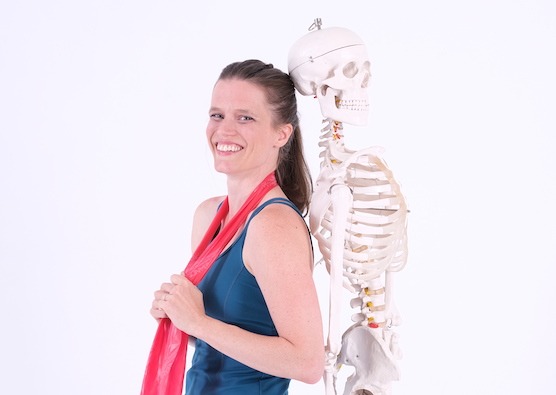A common question I get from students about poses like low boat (ardha navasana), where you lift your head up while lying supine, is “should I be feeling this in my neck?”
My teaching thrives on student questions like this one. I’ll often base entire classes off of them. That’s why in Hollow Body, Happy Neck, a class in my virtual studio, I addressed this question about the neck in a variety of ways, namely, in supine, core-focused moves.
Depending on how you look at it, the core includes the neck. But because we tend to treat our body like a collection of isolated parts, the neck work part of core work can get left out. On top of that (and unfortunately), the neck has been turned into a fragile, precious body part kept on the top shelf instead of out with the other toys in the playroom. We avoid moving it out of “neutral” because someone decided neutral was the only safe position. We strive to keep it “relaxed” all the time, because some other person decided activating neck muscles was a bad thing. If we feel sensation in our neck, that’s a bad, scary thing, and we should take some time off to recover, said a third person in charge of the body rules.

Never leaving neutral, never activating your neck muscles (which includes strengthening them), will likely make your neck stiff and creaky. In that condition, it’s probably not going to do all the things you actually need to be able to do with your neck, like lift your heavy head—for boat pose or, you know, getting out of bed or standing up.
How to Strengthen Your Neck
Moves like Hollow Body/Ardha Navasana are decent poses for some to work on neck strengthening because in order to lift our head off the ground, we need to use our neck muscles. And, to answer our original question, it might mean we feel that effort in our neck.
If your neck muscles are particularly taxed with an exercise, they will fatigue sooner than other muscles involved, in which case, you might feel it mostly in your neck. This is normal, and it’s potentially a good sign that you’re loading your neck in a way that will increase its capacity, especially if your neck muscles haven’t been used in a while.
You shouldn’t feel neck pain with an exercise, though. If you do, it’s time to reassess how much load you’re lifting (and decrease it), and the position you’re lifting from (and refine it). Position also matters, and sometimes exploring more optimal neck positions for the particular task is helpful.
Demystifying Neck Sensations
But, to begin to explore any of this, we need to dispel the many myths about “bad” neck positions or that you should never feel your neck working. We need to move our neck in more of the ways it can move, and find ways to strengthen it.
I liken this to opening up all the doors of your house and (imagining) discovering rooms you didn’t know you had. Discovering new ways your body can move can feel surprising, fortunate, and wonderful, too!
For many students these hidden “rooms” are:
full range of motion neck mobilizations
neck strengthening
shoulder blade positions that have been thrown in jail for being “illegal” (shoulder blade elevation and contracting upper trapezius)
It’s also important to let go of unhelpful, caked-on postural habits that we’ve adopted as “correct,” like always pulling your shoulders down away from our ears. (This can get old fast and cause a lot of neck discomfort.)
Here are some steps we took in Hollow Body, Happy Neck to prepare, load, and educate our necks:
- We warmed up your spine (and neck) together ahead of time, because the spine includes the neck.
- We loaded our shoulders in novel ways, like elevating (lifting them UP) them against resistance. We then mobilized our neck within that new context.
- We refined the timing of our neck mechanics with our core work, and paid attention to neck position.
- We used bands to offload the weight of the head in supine core work to down scale the load and further refine position.
- We practiced full range of motion core work to explore neck mechanics dynamically.


Leave a Reply